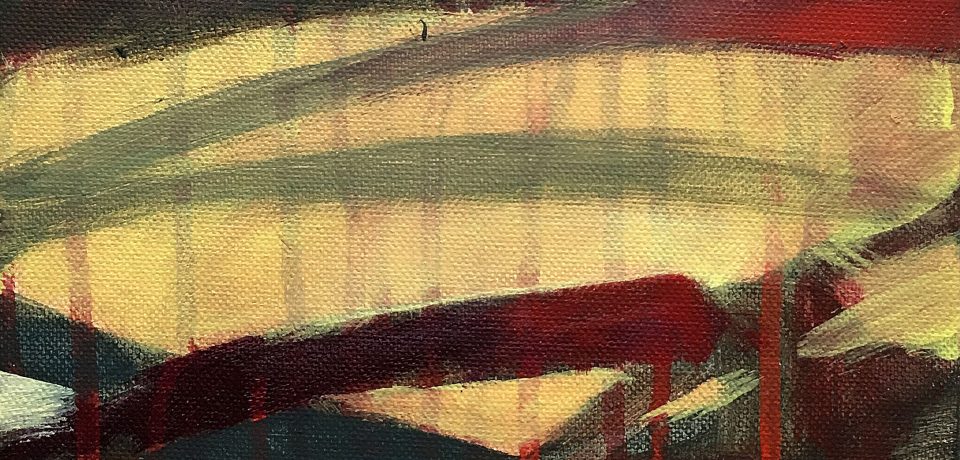I love abstract painting because it speaks to our time and creates a sort of emotional purity.
I love a challenge. Abstract painting can be hard to understand and even harder to create. Yet there’s a certain universality to it that it bridges communities in an incredible way. It just takes a little effort.

“Drawbridge,” acrylic on canvas. 8×8 inches, 2017.
I love how abstract painting speaks to our time
The longer I live, the more I see so many interpretations of the world and everything we all experience. There’s not just one experience or interpretation of the world, but many. (Or there is one experience, and variety is the very definition of it.) Interpretations are as varied as individuals. It makes life interesting! There’s so much to explore, and the Social Age gives so many a place to share and explore together.
It’s a lot like looking at clouds: everybody sees something a little different. When you look at an abstract artwork, your own interpretation is based on who you are and what you’ve experienced. Where highly realistic artwork often tells you what the interpretation is, abstract painting is open to interpretation. And a lot of times, your interpretation is a mirror of who you are.
At the same time, I can make a similar case for highly detailed, highly polished realistic or surrealistic artwork like that of my friend Sam Dunson, because your reaction has a lot to do with who you are and how you look at things.
Abstract painting reduces things to its essence
It’s easy to confuse abstraction with non-objectivity when you first begin looking at abstract art. Non-objective painting isn’t based on reality. It might be geometric or areas of color or pattern. Abstraction is based in reality. It just removes extra information so that the most important parts are shown. Abstract painting is challenging the way poetry is challenging: information is condensed, compressed, and edited.
A few years ago I came across Scott McCloud’s book Understanding Comics. He does a phenomenal job explaining the levels of abstraction, and how meaning is retained despite abstraction. What’s amazing is how the mind can see a circle with two dots and a line and interpret that as a face, when in fact it looks nothing like a face.

Page 31 from Understanding Comics: The human brain has the amazing ability to interpret an abstract circle, two dots, and a line as a face.
I love a challenge: abstract painting is a lot harder than it looks
I know a lot of people look at modern, abstract, and contemporary art and say, “I could do that,” or “my kid could do that.” (But you didn’t.)
The thing is, abstract art is a lot harder to pull off than it looks.
It looks simple enough to paint an entire canvas blue and call it art. But it takes a lot of mental and aesthetic gymnastics to get there. In hindsight it’s easy to see how over time, from the 1880s to the 1960s, art gets more and more simplified to the point where it gets reduced to a single color.
Creating good abstract art takes a lot of knowledge and understanding of composition plus the skill to pull it off. You have to understand things before you can deconstruct them. Picasso explored a different way of seeing space and time by showing multiple viewpoints at once, as well as express the horror he saw in the world. But before that, he was an excellent draftsman who knew how to render things as well as Rembrandt.
Abstract painting expresses an emotional purity unobscured by unnecessary details
Because abstraction is reduction and simplification, abstract painting isn’t weighed down by unnecessary details. Like I said earlier, it’s a lot like poetry since it is condensed and compressed. Showing the essence of a thing or idea allows it to be purer and more direct. The result is that abstract painting is often rawer and more visceral both in how it is seen and how it is painted.


